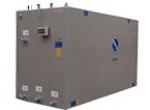As the name suggests, they use ice to build and store cooling when cooling demand and/or energy rates are low (mostly overnight), which the system then uses for air-conditioning or process purposes when energy rates are high (mostly daytime).
Benefits
- Refrigeration systems up to 50% more compact.
- Operational cost savings: ice formed overnight with cheaper electricity.
- Lower energy consumption basing the cooling system on average conditions rather than peak reduces power requirements and the refrigerant charge.
- Reduced carbon footprint: Most of the cooling occurs overnight when condensing temperatures are lower and the cooling system requires less energy.
- Less compressor maintenance since the compressor operates continuously at full capacity and not under fluctuating partial load.
- Thermal storage systems provide back-up cooling.
Systems
- External melt system (TSU-C/F and TSC) Direct ice/water contact ensures a constant low water temperature. External melt is ideal for applications requiring constant near-freezing water temperatures (1 to 2°C)
- Internal melt system (TSU-C/F). Internal melt is ideal for air-conditioning involving cooling at higher temperatures.
Coil is installed in factory-assembled modular tanks, several of which are usually needed for the required cooling load. They can be installed in basements, on roofs, and inside or outside buildings
- TSC features only a coil for ice thermal storage applications. The concrete tanks housing this are typically part of the building infrastructure.
Applications
Ice thermal storage is typically used for
- industrial and process cooling
- emergency cooling
- supermarkets
- dairies
- breweries
- meat processing
- wet air pre-cooling for storage of fruit and vegetables
Does ice thermal storage for your refrigeration system sound like a good option? Contact your local BAC representative and determine the optimal ice-melt system for your application.

